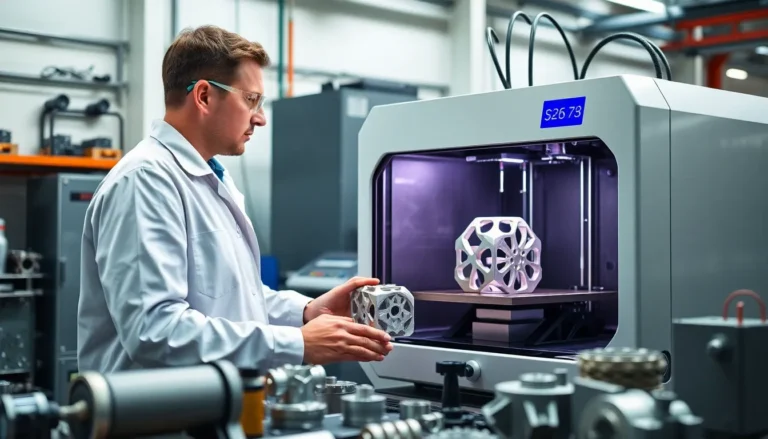In a world where flying cars are still a dream, multi-rotor drones have swooped in to steal the spotlight. These buzzing marvels are not just for tech enthusiasts or aerial photographers; they’re revolutionizing industries from agriculture to real estate. Imagine a tiny helicopter zipping around, capturing stunning views while you sip your coffee. Who wouldn’t want that?
With their nimble agility and impressive payload capabilities, multi-rotor drones are the Swiss Army knives of the sky. They can deliver packages, inspect infrastructure, and even help with search and rescue missions. Plus, they’re just plain fun to fly! Whether you’re a hobbyist or a business owner, these drones offer endless possibilities. So buckle up and prepare for takeoff—it’s time to explore the exciting world of multi-rotor drones.
Table of Contents
ToggleOverview of Multi Rotor Drones
Multi-rotor drones feature multiple propellers, usually ranging from four to eight, that provide stability and maneuverability. These unmanned aerial vehicles (UAVs) operate using electric power, ensuring quiet operation compared to gas-powered alternatives. Various configurations include quadcopters, hexacopters, and octocopters, each offering unique advantages for specific applications.
Drones find extensive use in agriculture for tasks like crop monitoring and precision spraying. Real estate professionals utilize these UAVs for aerial photography, capturing stunning images that enhance property listings. Package delivery services leverage multi-rotor technology to expedite shipping, reducing transit times significantly.
Infrastructure inspection has transformed due to drone capabilities, enabling detailed assessments of hard-to-reach structures such as bridges and towers. Search and rescue teams deploy these tools for rapid situational awareness in emergencies. Their ability to fly low and access remote areas substantially improves response times.
Safety features such as GPS stabilization and obstacle avoidance have become standard, minimizing the risk of accidents. Enhanced imaging technology, including thermal and night vision cameras, broadens operational possibilities. Battery life and payload capacity advancements also contribute to the growing popularity of multi-rotor drones.
Regulations governing drone operation vary by region but typically emphasize the importance of safety and privacy. Compliance with these laws ensures responsible use across industries. Multi-rotor drones bring efficiency, safety, and innovation, making them essential tools in modern applications.
Types of Multi Rotor Drones

Multi-rotor drones come in several configurations, each tailored for specific functions and applications. Three prominent types include quadcopters, hexacopters, and octocopters.
Quadcopter
Quadcopters comprise four rotors and have become the most popular type of multi-rotor drone. These drones offer a balance of efficiency and stability, making them ideal for recreational and commercial use. A wide variety of quadcopters exist, ranging from small models for beginners to advanced versions used in professional photography and videography. Their simple design leads to ease of use, contributing to their widespread appeal. Additionally, quadcopters typically feature strong GPS capabilities and smart flight modes, enabling precise hovering and automated missions.
Hexacopter
Hexacopters, equipped with six rotors, provide enhanced stability and payload capacity compared to quadcopters. These designs allow for greater lifting power, accommodating specialized equipment like high-resolution cameras and advanced sensors. A common application of hexacopters is in agriculture, where they support comprehensive crop monitoring and precision spraying. Due to their redundancy in rotor systems, hexacopters can maintain flight even if one rotor fails, enhancing safety during operations. Their versatility makes hexacopters suitable for tasks requiring both endurance and resilience.
Octocopter
Octocopters feature eight rotors, maximizing lift and stability for heavier payloads. This configuration supports sophisticated equipment often required in film production and industrial inspections. Their exceptional stability benefits applications like aerial surveying and mapping, providing more accurate data collection. Pilots control octocopters with confidence, knowing that the additional rotors offer greater redundancy. Such systems typically incorporate advanced features like real-time video streaming and automated flight paths, catering to professional users who require high performance.
Applications of Multi Rotor Drones
Multi-rotor drones serve a wide range of applications across various industries. Their versatility enhances efficiency, supports complex tasks, and improves safety in operations.
Aerial Photography and Videography
Aerial photography and videography benefit significantly from multi-rotor drones. Real estate professionals utilize these drones to capture stunning images of properties from unique angles. Commercial filmmakers rely on aerial footage for cinematic shots, elevating storytelling. Event planners use drones to document large gatherings or weddings, providing comprehensive views. These applications emphasize the quality of aerial shots that enhance marketing efforts.
Agricultural Monitoring
Multi-rotor drones play a crucial role in agricultural monitoring. Farmers deploy these drones to assess crop health through high-resolution imagery. Precision spraying improves input efficacy, targeting specific areas for pesticide or fertilizer application. Flying over fields allows for rapid data collection, reducing labor demands. Additionally, these drones enable timely interventions, maximizing yield potential by addressing issues before they escalate.
Search and Rescue Operations
Drones significantly enhance search and rescue operations in emergencies. First responders use them to assess disaster areas, gaining immediate situational awareness. Equipped with thermal imaging, drones locate missing persons quickly, even in low visibility conditions. They navigate challenging terrains, reaching areas inaccessible to ground teams. Public safety agencies benefit from faster response times, improving overall effectiveness in emergencies.
Advantages of Multi Rotor Drones
Multi-rotor drones offer a range of advantages that make them increasingly valuable across numerous fields. Their unique design contributes significantly to their operational benefits.
Maneuverability
Maneuverability stands out as a key advantage of multi-rotor drones. With multiple rotors, these drones achieve impressive stability and control, allowing for precise navigation in tight spaces. Quadcopter models excel in vertical takeoffs and landings, making them ideal for urban environments. Hexacopters and octocopters further enhance stability, accommodating complex aerial maneuvers when needed. These features enable operators to conduct detailed inspections or capture intricate aerial shots with ease. Additionally, multi-rotor drones can hover in place, facilitating targeted imaging or monitoring tasks. Overall, enhanced maneuverability positions multi-rotor drones as suitable tools for diverse applications.
Ease of Use
Ease of use represents another significant benefit of multi-rotor drones. User-friendly interfaces often accompany modern drones, making it simple for beginners to operate them effectively. Many models include automated flight modes, allowing for hands-free operation during essential tasks. Intuitive controls enable users to adjust settings quickly and adapt flight paths on the fly. Training resources and communities support new pilots, ensuring they gain confidence and skills fast. Furthermore, compatibility with mobile devices enhances accessibility, giving operators the ability to manage flights from smartphones or tablets. This simplicity fosters broader adoption across industries, driving innovation in areas like agriculture and real estate.
Challenges Facing Multi Rotor Drones
Multi-rotor drones encounter various challenges that can limit their effectiveness. Understanding these issues is vital for both operators and manufacturers.
Battery Life
Battery life presents a significant challenge for multi-rotor drones. Limited flight time often ranges from 20 to 40 minutes, depending on the model and payload. Shorter durations restrict operational capabilities in fields like aerial photography and agriculture. Manufacturers continually seek advanced battery technology to prolong flight times. LiPo (lithium polymer) batteries offer higher energy density, yet they require careful handling and charging. Future developments may focus on innovative energy sources that allow longer missions without frequent recharging.
Regulatory Restrictions
Regulatory restrictions also pose challenges for multi-rotor drone operations. Governments around the world enforce laws regarding altitude, no-fly zones, and privacy concerns. Compliance can complicate flights, especially in densely populated areas or near sensitive locations. Pilots must stay informed about local regulations to avoid penalties. The evolving legal landscape may impact drone applications in industries such as agriculture and delivery services. Striking a balance between innovation and regulation remains crucial to unlocking the full potential of multi-rotor drones.
Multi-rotor drones are transforming industries by providing innovative solutions that enhance efficiency and safety. Their versatility makes them invaluable in agriculture, real estate, and emergency response. As technology continues to advance, these drones will likely become even more integral to various applications.
With ongoing improvements in battery life and imaging capabilities, the potential for multi-rotor drones is vast. As regulations evolve, ensuring responsible use will be crucial in maximizing their benefits. The future of multi-rotor drones promises exciting developments that could reshape how tasks are performed across multiple sectors.




